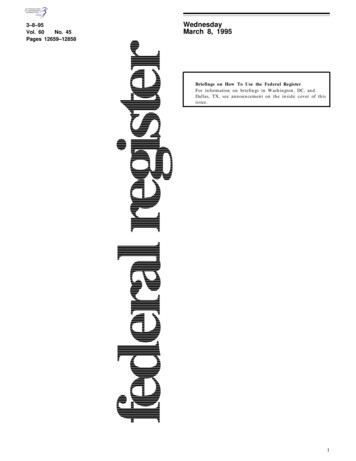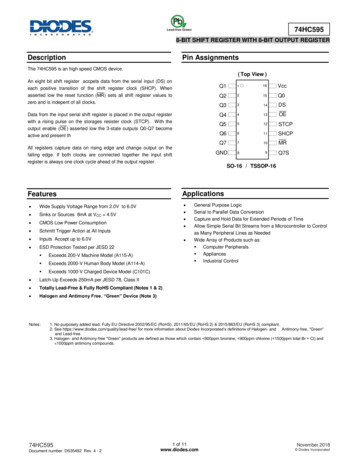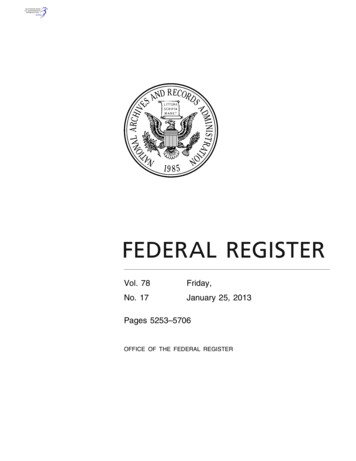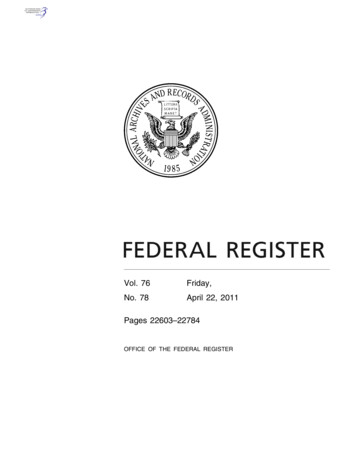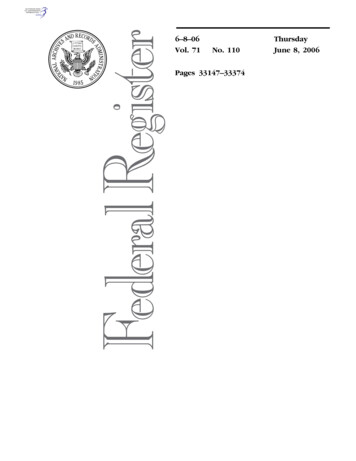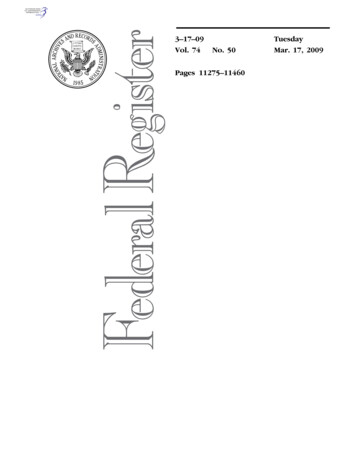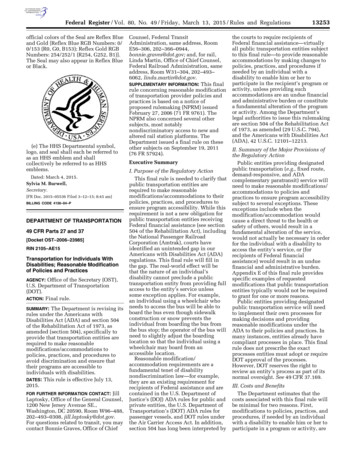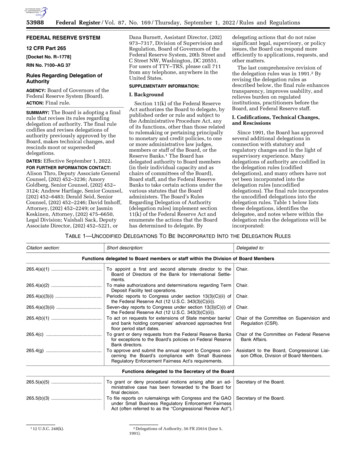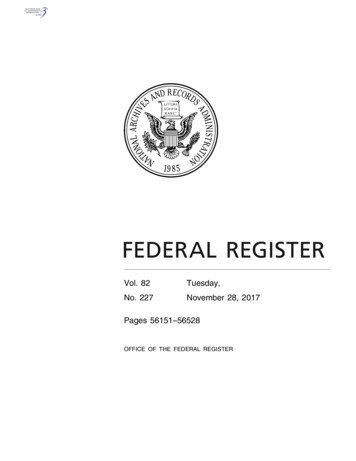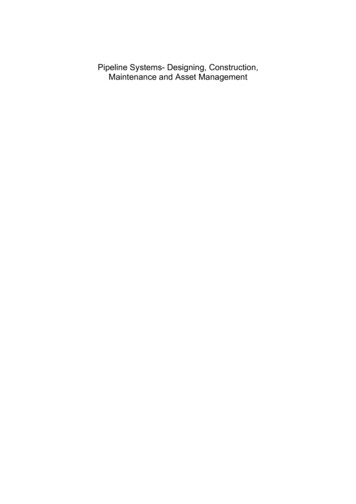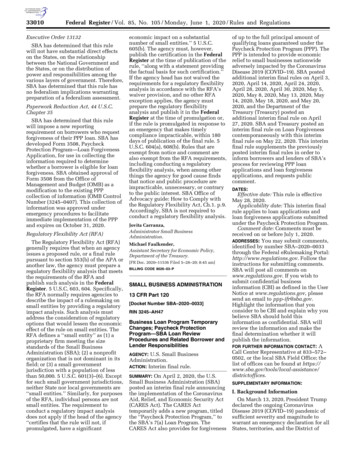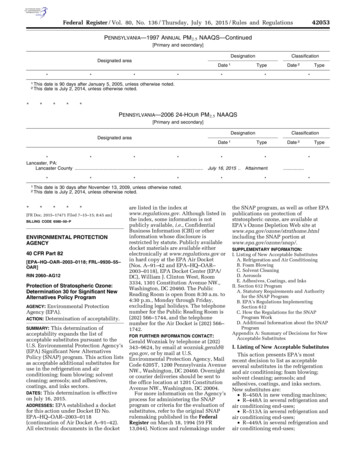
Transcription
42053Federal Register / Vol. 80, No. 136 / Thursday, July 16, 2015 / Rules and RegulationsPENNSYLVANIA—1997 ANNUAL PM2.5 NAAQS—Continued[Primary and secondary]DesignationClassificationDesignated areaDate 1****Type*Date 2*Type*1 Thisdate is 90 days after January 5, 2005, unless otherwise noted.2 This date is July 2, 2014, unless otherwise noted.*****PENNSYLVANIA—2006 24-HOUR PM2.5 NAAQS[Primary and secondary]DesignationClassificationDesignated areaDate 1****Lancaster, PA:Lancaster County .*1 This2 This****Date 2*July 16, 2015 .Attainment**Type*.*date is 30 days after November 13, 2009, unless otherwise noted.date is July 2, 2014, unless otherwise noted.****[FR Doc. 2015–17471 Filed 7–15–15; 8:45 am]BILLING CODE 6560–50–PENVIRONMENTAL PROTECTIONAGENCY40 CFR Part 82[EPA–HQ–OAR–2003–0118; FRL–9930–55–OAR]RIN 2060–AG12Protection of Stratospheric Ozone:Determination 30 for Significant NewAlternatives Policy ProgramEnvironmental ProtectionAgency (EPA).ACTION: Determination of acceptability.AGENCY:This determination ofacceptability expands the list ofacceptable substitutes pursuant to theU.S. Environmental Protection Agency’s(EPA) Significant New AlternativesPolicy (SNAP) program. This action listsas acceptable additional substitutes foruse in the refrigeration and airconditioning; foam blowing; solventcleaning; aerosols; and adhesives,coatings, and inks sectors.DATES: This determination is effectiveon July 16, 2015.ADDRESSES: EPA established a docketfor this action under Docket ID No.EPA–HQ–OAR–2003–0118(continuation of Air Docket A–91–42).All electronic documents in the docketSUMMARY:tkelley on DSK3SPTVN1PROD with RULES*TypeVerDate Sep 11 201416:14 Jul 15, 2015Jkt 235001are listed in the index atwww.regulations.gov. Although listed inthe index, some information is notpublicly available, i.e., ConfidentialBusiness Information (CBI) or otherinformation whose disclosure isrestricted by statute. Publicly availabledocket materials are available eitherelectronically at www.regulations.gov orin hard copy at the EPA Air Docket(Nos. A–91–42 and EPA–HQ–OAR–2003–0118), EPA Docket Center (EPA/DC), William J. Clinton West, Room3334, 1301 Constitution Avenue NW.,Washington, DC 20460. The PublicReading Room is open from 8:30 a.m. to4:30 p.m., Monday through Friday,excluding legal holidays. The telephonenumber for the Public Reading Room is(202) 566–1744, and the telephonenumber for the Air Docket is (202) 566–1742.FOR FURTHER INFORMATION CONTACT:Gerald Wozniak by telephone at (202)343–9624, by email at wozniak.gerald@epa.gov, or by mail at U.S.Environmental Protection Agency, MailCode 6205T, 1200 Pennsylvania AvenueNW., Washington, DC 20460. Overnightor courier deliveries should be sent tothe office location at 1201 ConstitutionAvenue NW., Washington, DC 20004.For more information on the Agency’sprocess for administering the SNAPprogram or criteria for the evaluation ofsubstitutes, refer to the original SNAPrulemaking published in the FederalRegister on March 18, 1994 (59 FR13,044). Notices and rulemakings underPO 00000Frm 00067Fmt 4700Sfmt 4700the SNAP program, as well as other EPApublications on protection ofstratospheric ozone, are available atEPA’s Ozone Depletion Web site atwww.epa.gov/ozone/strathome.htmlincluding the SNAP portion atwww.epa.gov/ozone/snap/.SUPPLEMENTARY INFORMATION:I. Listing of New Acceptable SubstitutesA. Refrigeration and Air ConditioningB. Foam BlowingC. Solvent CleaningD. AerosolsE. Adhesives, Coatings, and InksII. Section 612 ProgramA. Statutory Requirements and Authorityfor the SNAP ProgramB. EPA’s Regulations ImplementingSection 612C. How the Regulations for the SNAPProgram WorkD. Additional Information about the SNAPProgramAppendix A: Summary of Decisions for NewAcceptable SubstitutesI. Listing of New Acceptable SubstitutesThis action presents EPA’s mostrecent decision to list as acceptableseveral substitutes in the refrigerationand air conditioning; foam blowing;solvent cleaning; aerosols; andadhesives, coatings, and inks sectors.New substitutes are: R–450A in new vending machines; R–448A in several refrigeration andair conditioning end-uses; R–513A in several refrigeration andair conditioning end-uses; R–449A in several refrigeration andair conditioning end-uses;E:\FR\FM\16JYR1.SGM16JYR1
42054Federal Register / Vol. 80, No. 136 / Thursday, July 16, 2015 / Rules and Regulations Hydrofluoroolefin 1 (HFO)1336mzz(Z) in rigid polyurethane sprayfoam (high-pressure, two-part usesonly); and Methoxytridecafluorohepteneisomers (MPHE) in non-mechanical heattransfer, three solvent cleaning enduses, aerosol solvents, and adhesivesand coatings.For copies of the full list of acceptablesubstitutes for ozone depletingsubstances (ODS) in all industrialsectors, visit EPA’s Ozone LayerProtection Web site at www.epa.gov/ozone/snap/lists/index.html. Substituteslisted as unacceptable; acceptable,subject to narrowed use limits; oracceptable, subject to use conditions arealso listed in the appendices to 40 CFRpart 82, subpart G.The sections below discuss eachsubstitute listing in detail. Appendix Acontains tables summarizing today’slisting decisions for these newsubstitutes. The statements in the‘‘Further Information’’ column in thetables provide additional information,but are not legally binding under section612 of the Clean Air Act (CAA). Inaddition, the ‘‘Further Information’’column may not include acomprehensive list of other legalobligations you may need to meet whenusing the substitute. Although you arenot required to follow recommendationsin the ‘‘Further Information’’ column ofthe table to use a substitute consistentwith section 612 of the CAA, some ofthese statements may refer to obligationsthat are enforceable or binding underfederal or state programs other than theSNAP program. In many instances, theinformation simply refers to standardoperating practices in existing industrystandards and/or building codes. Whenusing these substitutes, EPA stronglyencourages you to apply the informationin this column. Many of theserecommendations, if adopted, wouldnot require significant changes toexisting operating practices.You can find submissions to EPA forthe substitutes listed in this document,as well as other materials supporting thedecisions in this action, in Docket EPA–HQ–OAR–2003–0118 atwww.regulations.gov.tkelley on DSK3SPTVN1PROD with RULESA. Refrigeration and Air Conditioning1. R–450AEPA’s decision: EPA finds R–450Aacceptable as a substitute for use in newequipment in vending machines.R–450A, marketed under the tradename Solstice N–13, is a weighted1 Hydrofluoroolefins are unsaturatedhydrofluorocarbons having at least one doublebond.VerDate Sep 11 201416:14 Jul 15, 2015Jkt 235001blend of 42 percent hydrofluorocarbon(HFC)-134a, which is also known as1,1,1,2-tetrafluoroethane (CAS Reg. No.811–97–2) and 58 percent HFO1234ze(E), which is also known astrans-1,3,3,3-tetrafluoroprop-1-ene (CASReg. No. 29118–24–9).You may find the redactedsubmission in Docket EPA–HQ–OAR–2003–0118 at www.regulations.govunder the name, ‘‘Solstice N–13 (R–450A) SNAP Information Notice.’’ EPAperformed assessments to examine thehealth and environmental risks of thissubstitute. These assessments areavailable in Docket EPA–HQ–OAR–2003–0118 under the following name: ‘‘Risk Screen on Substitutes for Usein Retail Food Refrigeration, VendingMachines, and Commercial IceMachines Substitute: R–450A’’EPA previously listed R–450A asacceptable for use as a refrigerant inseveral refrigeration and airconditioning end-uses (October 21,2014, 79 FR 62,863).Environmental information: R–450Ahas an ozone depletion potential (ODP)of zero. Its components, HFC-134a andHFO-1234ze(E), have global warmingpotentials (GWPs) of 1,430 2 and one tosix,3 respectively. When these valuesare weighted by mass percentage, thenR–450A has a 100-year integrated GWP(100-yr GWP) of about 600. Thecomponents of R–450A are bothexcluded from the definition of volatileorganic compounds (VOC) under CAAregulations (see 40 CFR 51.100(s))addressing the development of stateimplementation plans (SIPs) to attainand maintain the national ambient airquality standards (NAAQS). Knowinglyventing or releasing this refrigerantblend is limited by the ventingprohibition under section 608(c)(2) ofthe CAA, codified at 40 CFR82.154(a)(1).42 Unless otherwise stated, all GWPs in thisdocument are from: IPCC, 2007: Climate Change2007: The Physical Science Basis. Contribution ofWorking Group I to the Fourth Assessment Reportof the Intergovernmental Panel on Climate Change[Solomon, S., Qin, D., Manning, M., Chen, Z.,Marquis, M., Averyt, K. B., Tignor M., and Miller,H. L. (eds.)]. Cambridge University Press,Cambridge, United Kingdom and New York, NY,USA. This document is accessible at www.ipcc.ch/publications and data/ar4/wg1/en/contents.html.3 Hodnebrog, ;., Etminan, M., Fuglestvedt, J. S.,Marston, G., Myhre, G., Nielsen, C. J., Shine, K. P.,Wallington, T. J., Global Warming Potentials andRadiative Efficiencies of Halocarbons and RelatedCompounds: A Comprehensive Review, Reviews ofGeophysics, 51, 300–378, doi:10.1002/rog.20013,2013; Javadi, M. S., S ndergaard, R., Nielsen, O. J.,Hurley, M. D., and Wallington, T. J.: Atmosphericchemistry of trans-CF3CH CHF: products andmechanisms of hydroxyl radical and chlorine atominitiated oxidation. Atmospheric Chemistry andPhysics, 8, 3141–3147, 2008.4 For more information, including definitions, see40 CFR part 82 subpart F.PO 00000Frm 00068Fmt 4700Sfmt 4700Flammability information: R–450A asformulated and in the worst-casefractionation formulation is notflammable.Toxicity and exposure data: Potentialhealth effects of exposure to thissubstitute include drowsiness ordizziness. The substitute may alsoirritate the skin or eyes or causefrostbite. At sufficiently highconcentrations, the substitute may causeirregular heartbeat. The substitute couldcause asphyxiation if air is displaced byvapors in a confined space. Thesepotential health effects are common tomany refrigerants.The American Industrial HygieneAssociation (AIHA) has establishedWorkplace Environmental ExposureLevels (WEELs) of 1,000 ppm and 800ppm as 8-hour time-weighted averages(TWAs) for HFC-134a and HFO1234ze(E), the components of R–450A,respectively. The manufacturer of R–450A recommends an acceptableexposure limit (AEL) for the workplaceof 880 ppm on an 8-hour TWA for theblend. EPA anticipates that users will beable to meet each of the AIHA WEELsand the manufacturer’s AEL, andaddress potential health risks byfollowing requirements andrecommendations in the manufacturer’ssafety data sheet (SDS), in the AmericanSociety for Heating, Refrigerating, andAir-Conditioning Engineers (ASHRAE)Standard 15, and other safetyprecautions common to the refrigerationand air conditioning industry.Comparison to other substitutes inthis end-use: R–450A has an ODP ofzero, comparable 5 to or lower thanother listed substitutes. R–450A’s GWPof about 600 is higher than that of someacceptable substitutes in this end-use,such as CO2 with a GWP of one andpropane (R–290), isobutane (R–600a),and R–441A with GWPs ranging fromthree to eight; is comparable to IKON–B’s GWP of approximately 550; and islower than FRIGC FR–12’s GWP ofapproximately 1,080.6 Flammabilityrisks are low, as discussed above, andare comparable to flammability risks ofother available substitutes in the sameend-use. The toxicity risks are similar tothose for many other refrigerants and, aswith those other refrigerants, can beminimized by use consistent with theAIHA WEELs, ASHRAE 15 and other5 This is in contrast to the historically used ODShydrochlorofluorocarbon (HCFC)–22 with an ODPof 0.055.6 Propane (R–290), isobutane (R–600a), and R–441A are acceptable, subject to use conditions, inthis end-use. These three substitutes are subject toa use condition restricting charge sizes to 150 grams(g) or less and thus may limit their use forequipment that requires larger charge sizes.E:\FR\FM\16JYR1.SGM16JYR1
Federal Register / Vol. 80, No. 136 / Thursday, July 16, 2015 / Rules and Regulationsof 675; 3,500; 1,430; one to four; 7 8 andone to six; 9 respectively. If these valuesare weighted by mass percentage, thenR–448A has a GWP of about 1,390. Thecomponents of R–448A are excludedfrom the definition of VOC under CAAregulations (see 40 CFR 51.100(s))addressing the development of SIPs toattain and maintain the NAAQS.Knowingly venting or releasing thisrefrigerant blend is limited by theventing prohibition under section608(c)(2) of the CAA, codified at 40 CFR82.154(a)(1).Flammability information: R–448A as2. R–448Aformulated and in the worst-casefractionation formulation is notEPA’s decision: EPA finds R–448Aflammable.acceptable as a substitute for use in:Toxicity and exposure data: Potential Commercial ice machines (new andhealtheffects of exposure to thisretrofit equipment)substitute include drowsiness or Refrigerated transport (new anddizziness. The substitute may alsoretrofit equipment)irritate the skin or eyes or cause Retail food refrigeration—lowfrostbite. At sufficiently hightemperature stand-alone equipmentconcentrations, the substitute may cause(i.e., equipment designed to maintainirregular heartbeat. The substitute couldinternal temperatures at 32 F (0 C)cause asphyxiation if air is displaced byor below) (new and retrofitvapors in a confined space. Theseequipment)potential health effects are common to Retail food refrigeration—supermarketmany refrigerants.systems and remote condensing unitsThe AIHA has established WEELs of(new and retrofit equipment)1,000 ppm as an 8-hr TWA for HFC-32,R–448A, marketed under the tradeHFC-125, and HFC-134a; 500 ppm forname Solstice N–40, is a weightedHFO-1234yf; and 800 ppm for HFOblend of 26 percent HFC-32, which is1234ze(E), the components of R–448A.also known as difluoromethane (CASThe manufacturer of R–448AReg. No. 75–10–5); 26 percent HFC-125, recommends an AEL of 890 ppm on anwhich is also known as 1,1,1,2,28-hour TWA for the blend. EPApentafluoroethane (CAS Reg. No. 354–anticipates that users will be able to33–6); 21 percent HFC-134a, which ismeet the AIHA WEELs andalso known as 1,1,1,2-tetrafluoroethanemanufacturer’s AEL, and address(CAS Reg. No. 811–97–2); 20 percentpotential health risks by followingHFO-1234yf, which is also known asrequirements and recommendations in2,3,3,3-tetrafluoroprop-1-ene (CAS Reg.the SDS, in ASHRAE 15, and otherNo 754–12–1); and 7 percent HFOsafety precautions common to the1234ze(E), which is also known asrefrigeration and air conditioningtrans-1,3,3,3-tetrafluoroprop-1-ene (CAS industry.Reg. No. 29118–24–9).Comparison to other substitutes inYou may find the redactedthese end-uses: R–448A has an ODP ofsubmission in Docket EPA–HQ–OAR–zero, comparable 10 to or lower than the2003–0118 at www.regulations.govother substitutes acceptable in theseunder the name, ‘‘Solstice N–40 (R–end-uses.In refrigerated transport, many448A) SNAP Information Notice.’’ EPAsubstitutes listed as acceptable haveperformed assessments to examine thecomparable or higher GWPs, such ashealth and environmental risks of thisHFC-134a, R–404A, and other HFCsubstitute. These assessments arerefrigerant blends, with GWPs rangingavailable in Docket EPA–HQ–OAR–from 1,430 to approximately 3,990;2003–0118 under the following names: ‘‘Risk Screen on Substitutes for Use7 Hodnebrog et al., 2013. Op. cit.in Retail Food Refrigeration and8 Nielsen, O. J., Javadi, M. S., Sulbaek Andersen,Commercial Ice Machines Substitute: R–M. P., Hurley, M. D., Wallington, T. J., Singh, R.448A’’Atmospheric chemistry of CF3CF CH2: Kinetics and ‘‘Risk Screen on Substitutes for Use mechanisms of gas-phase reactions with Cl atoms,in Refrigerated Transport Substitute: R– OH radicals, and O3. Chemical Physics Letters 439,18–22, 2007.448A’’9 Hodnebrog et al., 2013 and Javadi et al., 2008.Environmental information: R–448AOp. cit.has an ODP of zero. Its components,10 This is in contrast to the historically used ODSHFC-32, HFC-125, HFC-134a, HFOchlorofluorocarbon (CFC)-12, R–502A, and HCFC–22 with ODPs ranging from 0.055 to 1.0.1234yf, and HFO-1234ze(E) have GWPstkelley on DSK3SPTVN1PROD with RULESindustry standards, recommendations inthe SDS, and other safety precautionscommon in the refrigeration and airconditioning industry; moreover, theserisks are common to many refrigerants,including many of those already listedas acceptable under SNAP.EPA finds R–450A acceptable in theend-use listed above, because theoverall environmental and humanhealth risk posed by R–450A is lowerthan or comparable to the risks posed byother substitutes acceptable in the sameend-use.VerDate Sep 11 201417:39 Jul 15, 2015Jkt 235001PO 00000Frm 00069Fmt 4700Sfmt 470042055other substitutes listed as acceptablesubstitutes for refrigerated transporthave a lower GWP including R–450A,CO2, direct nitrogen expansion, andStirling cycle, with GWPs ranging fromzero to about 600.For commercial ice machines, manysubstitutes listed as acceptable havecomparable or higher GWPs, such asHFC-134a, R–404A, and other HFCblends with GWPs ranging fromapproximately 1,400 to 3,990; othersubstitutes listed as acceptablesubstitutes for commercial ice machineshave a lower GWP including ammoniaabsorption, ammonia vaporcompression, Stirling cycle, and R–450A with GWPs ranging from zero toabout 600.R–448A’s GWP of about 1,390 iscomparable to or lower than a numberof other substitutes listed as acceptablein retail food refrigeration—supermarketsystems and remote condensing units,including three of the more commonlyused substitutes at this time: HFC-134a,R–407A, and R–407C, with GWPsranging from 1,430 to approximately2,110. R–448A’s GWP of about 1,390 ishigher than the GWP of some otheracceptable substitutes in retail foodrefrigeration—supermarket refrigerationsystems and remote condensing units,including CO2 with a GWP of one andR–450A with a GWP of about 600.R–448A’s GWP of about 1,390 iscomparable to the GWP of severalrefrigerants listed as acceptable for theretail food refrigeration-low-temperaturestand-alone equipment end-use: HFC134a with a GWP of 1430 and a numberof HFC blends with GWPs in the rangeof 1,100 to 1,500.11 The GWP of R–448Ais higher than that of some other listedsubstitutes for the low-temperaturestand-alone equipment end-use,including CO2, propane, isobutane, andR–441A (with GWPs ranging from oneto eight).Flammability risks are low, asdiscussed above, and are comparable toflammability risks of other availablesubstitutes in the same end-uses.Toxicity risks can be minimized by useconsistent with the AIHA WEELs,11 Historically, under the SNAP listings, we havenot subdivided the retail food refrigeration—standalone equipment end-use. In the final rule thatchanges the status of certain refrigerants for thisend-use and which we are issuingcontemporaneously with this action, we havedetermined that the refrigerant choices for lowtemperature stand-alone equipment, for whichgreater cooling capacity is required, are morelimited than for other stand-alone equipment(which we refer to as medium-temperatureequipment). In that action, we subdivided thestand-alone equipment end-use. Therefore, in thisaction we are evaluating low-temperatureequipment and medium-temperature equipment asseparate end-uses.E:\FR\FM\16JYR1.SGM16JYR1
42056Federal Register / Vol. 80, No. 136 / Thursday, July 16, 2015 / Rules and Regulationshealth and environmental risks of thissubstitute. These assessments areavailable in Docket EPA–HQ–OAR–2003–0118 under the following names: ‘‘Risk Screen on Substitutes for Use inChillers and Industrial Process AirConditioning Substitute: R–513A’’ ‘‘Risk Screen on Substitutes for Use inCold Storage Warehouses andIndustrial Process RefrigerationSubstitute: R–513A’’ ‘‘Risk Screen on Substitutes for Use inHousehold Refrigerators and Freezersand Water Coolers Substitute: R–513A’’ ‘‘Risk Screen on Substitutes for Use inRefrigerated Transport Substitute: R–3. R–513A513A’’ ‘‘Risk Screen on Substitutes for Use inEPA’s decision: EPA finds R–513ARetail Food Refrigeration, Vendingacceptable as a substitute for use in:Machines, and Commercial Ice Centrifugal chillers (new and retrofitMachines Substitute: R–513A’’equipment)Environmental information: R–513A Cold storage warehouses (new andhas an ODP of zero. Its components,retrofit equipment)HFC-134a and HFO-1234yf, have GWPs Commercial ice machines (new andof 1,430 and one to four,13 respectively.retrofit equipment)If these values are weighted by mass Household refrigerators and freezerspercentage, then R–513A has a GWP of(new and retrofit equipment) Industrial process air-conditioningabout 630. The components of R–513Aare both excluded from the definition of(new and retrofit equipment) Industrial process refrigeration (newVOC under CAA regulations (see 40and retrofit equipment)CFR 51.100(s)) addressing the Reciprocating, screw and scrolldevelopment of SIPs to attain andchillers (new and retrofit equipment)maintain the NAAQS. Knowingly Refrigerated transport (new andventing or releasing this refrigerantretrofit equipment)blend is limited by the venting Retail food refrigeration—lowprohibition under section 608(c)(2) oftemperature and mediumthe CAA, codified at 40 CFRtemperature 12 stand-alone equipment 82.154(a)(1).(new and retrofit equipment)Flammability information: R–513A as Retail food refrigeration—supermarket formulated and in the worst-casesystems and remote condensing units fractionation formulation is not(new and retrofit equipment)flammable. Vending machines (new and retrofitToxicity and exposure data: Potentialequipment)health effects of exposure to this Water coolers (new and retrofitsubstitute include drowsiness orequipment)dizziness. The substitute may alsoirritate the skin or eyes or causeR–513A, marketed under the tradefrostbite. At sufficiently highname Opteon XP 10, is a weightedblend of 44 percent HFC-134a, which is concentrations, the substitute may causeirregular heartbeat. The substitute couldalso known as 1,1,1,2 tetrafluoroethanecause asphyxiation if air is displaced by(CAS Reg. No. 811–97–2); and 56vapors in a confined space. Thesepercent HFO-1234yf, which is alsopotential health effects are common toknown as 2,3,3,3-tetrafluoroprop-1-enemany refrigerants.(CAS Reg. No. 754–12–1).The AIHA has established WEELs ofYou may find the redacted1,000 ppm and 500 ppm as an 8-hoursubmission in Docket EPA–HQ–OAR–TWA for HFC-134a and HFO-1234yf,2003–0118 at www.regulations.govrespectively, the components of R–under the name, ‘‘Opteon XP 10 (R–513A. The manufacturer of R–513A513A) SNAP Information Notice.’’ EPArecommends an AEL of 653 ppm on anperformed assessments to examine the8-hour TWA for the blend. EPA12 As provided in the listing decision for R–448Aanticipates that users will be able tofor retail food refrigeration, we are making separatemeet each of the AIHA WEELs and thelisting decisions for low-temperature stand-alonemanufacturer’s AEL, and addressequipment (i.e. equipment designed to maintainpotential health risks by followinginternal temperatures at 32 F (0 C) or below) andtkelley on DSK3SPTVN1PROD with RULESASHRAE 15, and other industrystandards, recommendations in the SDS,and other safety precautions common inthe refrigeration and air conditioningindustry; moreover, those risks arecommon to many refrigerants, includingmany of those already listed asacceptable under SNAP for these sameend-uses.EPA finds R–448A acceptable in theend-uses listed above, because theoverall environmental and humanhealth risk posed by R–448A is lowerthan or comparable to the risks posed byother substitutes found acceptable in thesame end-uses.medium-temperature equipment (i.e., stand-aloneequipment designed to maintain internaltemperatures above 32 F (0 C).VerDate Sep 11 201417:39 Jul 15, 2015Jkt 23500113 Hodnebrog et al., 2013 and Nielsen et al., 2007.Op. cit.PO 00000Frm 00070Fmt 4700Sfmt 4700requirements and recommendations inthe SDS, in ASHRAE 15, and othersafety precautions common to therefrigeration and air conditioningindustry.Comparison to other substitutes inthese end-uses: R–513A has an ODP ofzero, comparable 14 to or lower thanother listed substitutes in these enduses.R–513A’s GWP of about 630 iscomparable to or lower than a numberof other substitutes in retail foodrefrigeration—supermarket systems andremote condensing units, including R–450A, HFC-134a, R–407A, R–407C, anda number of HFC blends, with GWPsranging from approximately 600 to2,110. R–513’s GWP of about 630 ishigher than those of some otheracceptable substitutes in new retail foodrefrigeration—supermarket refrigerationsystems and remote condensing units,including CO2 with a GWP of one.In retail food refrigeration—lowtemperature stand-alone equipment, R–513A’s GWP of about 630 is comparableto or lower than a number of othersubstitutes, including IKON B, R–450A,FRIGC FR–12, HFC-134a, and R–426Awith GWPs ranging fromapproximately 550 to approximately1,500. In retail food-refrigeration—medium temperature stand-aloneequipment and vending machines, R–513A’s GWP of about 630 is higher thanthat of some acceptable substitutes inthis end-use, such as CO2 with a GWPof one and propane (R–290), isobutane(R–600a), and R–441A with GWPsranging from three to eight; iscomparable to the GWPs of IKON–B andR–450A, which are approximately 550to 600; and is lower than FRIGC FR–12’sGWP of approximately 1,080.15In refrigerated transport, manysubstitutes listed as acceptable havecomparable or higher GWPs, such as R–450A, HFC-134a, R–404A, and otherHFC refrigerant blends, with GWPsranging from approximately 600 toapproximately 3,990; acceptablesubstitutes for refrigerated transportwith a lower GWP include CO2, directnitrogen expansion, and Stirling cycle,with GWPs in the range of zero to one.For cold storage warehouses andindustrial process refrigeration, manysubstitutes listed as acceptable havecomparable or higher GWPs, such as R–14 This is in contrast to the historically used ODSCFC–12, R–502A, and HCFC–22 with ODPs rangingfrom 0.055 to 1.0.15 Propane (R–290), isobutane (R–600a), and R–441A are acceptable, subject to use conditions, inthis end-use. These three substitutes are subject toa use condition restricting charge sizes to 150 g orless and thus may limit their use for equipment thatrequires larger charge sizes.E:\FR\FM\16JYR1.SGM16JYR1
tkelley on DSK3SPTVN1PROD with RULESFederal Register / Vol. 80, No. 136 / Thursday, July 16, 2015 / Rules and Regulations450A, HFC-134a, R–404A, and otherHFC refrigerant blends, with GWPsranging from approximately 600 toapproximately 3,990; acceptablesubstitutes for new cold storagewarehouses and for industrial processrefrigeration with a lower GWP includeCO2 and ammonia with GWPs in therange of zero to one.For commercial ice machines, mostother substitutes listed as acceptablehave comparable or higher GWPs, suchas R–450A, R–404A and other HFCblends with GWPs ranging fromapproximately 600 to 3,990. Ammoniavapor compression with a GWP of zerois also an acceptable substitute in thisend-use.In household refrigerators andfreezers, many substitutes listed asacceptable have comparable or higherGWPs than R–513A, such as R–450A,R–134a, R–404A and other HFC blendswith GWPs ranging from approximately600 to 3,990. R–513A’s GWP ofapproximately 630 is higher than thoseof some other acceptable substitutes inthis end-use for new equipment,including propane, isobutane, and R–441A 16 (with GWPs ranging from threeto eight), and HFC-152a with a GWP of124.For centrifugal, reciprocating, screwand scroll chillers, most othersubstitutes listed as acceptable havecomparable or higher GWPs, such as R–450A, R–134a, R–404A and other HFCblends with GWPs ranging fromapproximately 600 to 3,990. In theseend-uses, acceptable substitutes withlower GWPs for new equipment includeammonia absorption and ammoniavapor compression, HFO-1234ze(E), andfor centrifugal chillers only, trans-1chloro-3,3,3,-trifluoroprop-1-ene, withGWPs in the range of zero to seven.For industrial process airconditioning and water coolers, all othersubstitutes listed as acceptable havecomparable or higher GWPs, such as R–450A, R–134a, R–404A and other HFCblends with GWPs ranging fromapproximately 600 to 3,990.Flammability risks are low, asdiscussed above, and are comparable toflammability risks of other availablesubstitutes in the same end-uses.Toxicity risks can be minimized by useconsistent with the AIHA WEELs,ASHRAE 15 and other industrystandards, recommendations in the SDS,and other safety precautions common inthe refrigeration and air conditioning16 Propane (R–290), isobutane (R–600a), and R–441Aare acceptable, subject to use conditions, inthis end-use. These three substitutes are subject toa use condition restricting charge sizes to 57 g orless and thus may limit their use for equipment thatrequires larger charge sizes.VerDate Sep 11 201417:49 Jul 15, 2015Jkt 23500142057industry; moreover, those risks arecommon to many refrigerants, includingmany of those already listed asacceptable under SNAP for these sameend-uses.EPA finds R–513A acceptable in theend-uses listed above, because theoverall environmental and humanhealth risk posed by R–513A is lowerthan or comparable to the risks posed byother substitutes found acceptable in thesame end-uses.51.100(s)) addressing the developmentof SIPs to attain and maintain theNAAQS. Knowingly venting or releasingthis refrigerant blend is limited by theventing prohibition under section608(c)(2) of the CAA, codified at 40 CFR82.154(a)(1).Flammability information: R–449A asformulated and in the worst-casefractionation formulation is notflammable.Toxicity and exposure data: Potentialhealth effects of exposure to this4. R–449Asubstitute include drowsiness orEPA’s decision: EPA finds R–449Adizziness. The substitute may alsoacceptable as a substitute for use in:irritate the sk
Federal Register/Vol. 80, No. 136/Thursday, July 16, 2015/Rules and Regulations 42053 PENNSYLVANIA—1997 ANNUAL PM 2.5 NAAQS—Continued [Primary and secondary] Designated area Designation Classification Date1 Type Date2 Type 1 This date is 90 days after January 5, 2005, unless otherwise noted. 2 This date is July 2, 2014, unless otherwise noted. PENNSYLVANIA—2006 24-HOUR PM
